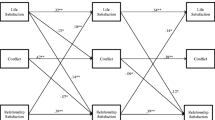Abstract
This study uses feminist theory to examine the variables of relationship length and relationship satisfaction as predicators of both self-esteem and emotional functioning for women. Using a national sample of data gathered from 1,257 female survey respondents this study found significant relationships between emotional functioning, self-esteem, and self-reported relationship satisfaction which was supported by regression testing and path analysis. In addition, a significant negative relationship was noted between a woman's self-esteem and her with-holding of verbalized displeasure or disagreement with her partner. Implications for women in therapy were discussed.
Similar content being viewed by others
REFERENCES
American Psychiatric Association. (1987). Diagnostic and statistical manual of mental disorders (3rd. ed.). Washington, DC: Author
Barnett, J., & Baruch, G. (1981). Women in the middle-years: A critique of research and theory. In S. Cox (Ed.), Female psychology: The emerging self (pp.283–291). New York: St. Martin's Press.
Bateson, M. C. (1990). Composing a life. New York: Plume Books.
Bayes, M. (1988). The prevalence of gender-role bias in mental health services. In E. Howell & M. Bayes (Eds.), Women and mental health (pp. 83–85). New York: Basic Books.
Beattie, M. (1987). Codependent no more. New York: Harper & Row.
Beavers, W. (1982). Healthy, midrange, and severely dysfunctional families. In F. Walsh (Ed.), Normal family processes (pp. 45–66). New York: Guilford.
Benningfield, A. (1992, October). Women's changing expectations in marriage. Family Therapy News, p. 11.
Bernard, J. (1982). The future of marriage. New Haven: Yale University Press.
Boss, P. & Weiner, P. (1988). Rethinking assumptions about women's development and family therapy. In C. Falicov (Ed.), Family transitions (pp. 235–254). New York: Guilford.
Brownmiller, S. (1984). Femininity. New York: Linden Press.
Bunch, C. (1987). Passionate politics: Feminist theory in action. New York: St. Martin's Press.
Caldwell, R., Bloom, B., & Hodges, W. (1984). Sex differences in separation divorce: A longitudinal perspective. In A. Rickel, M. Gerrard, & I. Iscoe (Eds.), Social and psychological problems of women: Prevention and crisis intervention (pp. 103–120). Washington, DC: Hemisphere Publishers.
Chesler, P. (1981). Women as psychiatric and psychotherapeutic patients. In S. Cox (Ed.), Female psychology: The emerging self (pp. 298–319). New York: St. Martin's Press.
Cox, S. (1981). Mental illness or social problem? In S. Cox (Ed.), Female psychology: The emerging self (pp. 292–297). New York: St. Martin's Press.
Faludi, S. (1991). Backlash: The undeclared war against American women. New York: Crown Publishers.
Gerstel, N. (1988). Divorce and kin ties: The importance of gender. Journal of Marriage and the Family, 50, 209–219.
Gilligan, C. (1985). In a different voice: Woman's conceptions of self and morality. In S. Rich & A. Phillips (Eds.), Women's experience and education (pp. 187–223). Cambridge: Harvard Educational Review Reprint Series #17.
Goldberg, R. (1994, December). Papp illuminates depression with gender role analysis. Family Therapy News, p. 25.
Hare-Mustin, R. (1988). Family change and gender differences: Implications for theory and practice. Family Relations, 37, 36–41.
Heim, S., & Snyder, D. (1991). Predicting depression from marital distress and attributional processes. Journal of Marital and Family Therapy, 17, 67–72.
Hite, S. (1989). Women and love: A cultural revolution in progress. New York: St. Martin's Press.
Holman, T., Busby, D., & Larson, J. (1989). Preparation for Marriage:Prep-M. Provo, UT: Brigham Young University.
Kaschak, E. (1981). Feminist psychotherapy: The first decade. In S. Cox (Ed.), Female psychology: The emerging self (pp. 387–401). New York: St. Martin's Press.
Lerner, H. G. (1988). Women in therapy. New York: Harper & Row.
Leupnitz, D. (1988). The family interpreted. New York: Basic Books.
Lewis, J. (1989). The birth of the family. New York: Brunner/Mazel.
Pierce, C. (1971). Natural law language and women. In V. Gornick & B. Moran (Eds.), Woman in sexist society: Studies in power and powerlessness (pp. 243–258). New York: Basic Books.
Perry-Jenkins, M., Seery, B., & Crouter, A. (1992). Linkages between women's provider role attitudes, psychological well-being, and family relationships. Psychology of Women Quarterly, 16, 311–329.
Radloff, L. & Cox, S. (1981). Differences in depression in relation to learned susceptibility. In S. Cox (Ed.), Female psychology: The emerging self (pp. 334–350). New York: St. Martin's Press.
Rubin, L. (1979). Intimate strangers. New York: Harper & Row.
Scanzoni, J., Polonko, K., Teachman, J., & Thompson, L. (1989). The sexual bond: Rethinking families and close relationships. Newbury Park: Sage.
Spiegel, D. (1982). Mothering, fathering, and mental illness. In B. Thorne & M. Yalom (Eds.), Rethinking the family: Some feminist questions (pp. 95–110). New York: Longman.
Stake, J. (1992). Gender differences and similarities in self-concept within everyday life contexts. Psychology of Women Quarterly, 16, 349–363.
Tavris, C., & Wade, C. (1984). The longest war. New York: Harcourt, Brace, & Jovanovich.
Tavris, C. (1992). The mismeasure of women. New York: Simon & Schuster.
Vital Statistics of the U.S. (1991). Marriage and divorce, 1987. Rockville, MD: US Department of Health and Human Services.
Wallerstein, J., & Blakeslee, S. (1989). Second chances. New York: Ticknor & Fields.
Walters, M. (1990). A feminist perspective in family therapy. In M. Mirkin (Ed.), The social and political contexts of family therapy (pp.51–68). Boston: Allyn & Bacon.
Walters, M., Carter, B., Papp, P., & Silverstein, O. (1988). The invisible web: Gender patterns in family relationships. New York: Guilford.
Weisstein, N. (1971). Psychology constructs the female. In V. Gornick & B. Moran (Eds.), Woman in sexist society: Studies in power and powerlessness (pp. 207-224). New York: Basic Books
Williams, J. (1977). Psychology of woman: Behavior in a biosocial context. New York: Norton
Author information
Authors and Affiliations
Rights and permissions
About this article
Cite this article
Wright, C.I., Busby, D.M. Relationship Satisfaction: Impact and Consequences for Women's Emotional Health and Treatment. Contemporary Family Therapy 19, 443–460 (1997). https://doi.org/10.1023/A:1026176412844
Issue Date:
DOI: https://doi.org/10.1023/A:1026176412844




